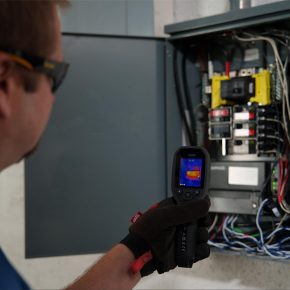
How an air conditioner works
Invented in 1902 by Willis Haviland Carrier, the air conditioner was originally created for humidity control because the air at a publishing company sometimes absorbed moisture from the warm air, making it extremely difficult to apply inking techniques.
Carrier got the air inside the building and blew it across chilled pipes, reducing the humidity and resolving the issue.
Air conditioners contain a chemical which converts from a gas to a liquid, and then back to a gas again. This chemical is utilised to transfer heat from the air inside of a property to the outside air.
There are two types of air conditioners which are indoor and outdoor units. Both machines comprise three core components; a compressor, a condenser and an evaporator.
Indoor units
Indoor units consist of a coil box which contains an evaporator. This allows for the refrigerant, a cooling fluid which is inside the coil, to evaporate and absorb heat. Once the heat is absorbed, cool air is sent back into the property.
Outdoor units
Outdoor units contain a compressor which distributes heat from outside the property. The heat which is absorbed from the air is then transferred to the refrigerant and pumped into the outdoor unit.
As the heat is absorbed and moved by the outdoor coil, it passes through the compressor. The refrigerant is then compressed to a higher pressure and moved through the condenser.
As the refrigerant goes through the condenser, a fan delivers cool air across the condenser. The heat from inside the property is then distributed to the air outside.
To find out more about air conditioners and how they work contact PAR Refrigeration
Latest news

25th April 2025
Quicker and Easier Inspections with High Performance FLIR Testing Solutions
FLIR, a Teledyne Technologies company, introduces its PV range of inspection solutions to expedite panel installation and maintenance at solar farms, commercial buildings, and residential buildings.
Posted in Articles, Building Industry News, Building Products & Structures, Building Services, Facility Management & Building Services, Information Technology, Innovations & New Products, Research & Materials Testing, Restoration & Refurbishment, Retrofit & Renovation, Sustainability & Energy Efficiency, Thermal Imaging and Monitors
25th April 2025
Schlüter-Systems: Common costly mistakes when renovating a bathroom
With nearly six decades of experience in the bathroom world, Schlüter-Systems knows all there is to know about the challenges of installing a perfect one!
Posted in Articles, Bathrooms & Toilets, Bathrooms, Bedrooms & Washrooms, Building Industry News, Building Products & Structures, Building Services, Damp & Waterproofing, Drainage, Drainage Services, Drainage, Guttering, Soffits & Fascias, Heating, Ventilation and Air Conditioning - HVAC, Interior Design & Construction, Interiors, Membranes, Pipes & Fittings, Plumbing, Restoration & Refurbishment, Retrofit & Renovation, Walls
25th April 2025
Newcastle United enhances fans’ experience with Stannah escalators
Newcastle United Football Club has introduced two new Stannah escalators as part of a refurbishment of its on-site merchandising outlet.
Posted in Accessibility, Articles, Building Industry News, Building Products & Structures, Building Services, Case Studies, Facility Management & Building Services, Restoration & Refurbishment, Retrofit & Renovation
24th April 2025
Gemini: Using Data Loggers to Help Analyse Environmental Conditions and Energy Usage in Buildings
Gemini Tinytag Data Loggers record environmental parameters over time, allowing conditions to be measured, documented, analysed, and validated.
Posted in Articles, Building Industry News, Building Products & Structures, Building Services, Facility Management & Building Services, Health & Safety, Heating Systems, Controls and Management, Heating, Ventilation and Air Conditioning - HVAC, Information Technology, Research & Materials Testing, Restoration & Refurbishment, Retrofit & Renovation, Sustainability & Energy Efficiency, Thermal Imaging and Monitors
 Sign up:
Sign up: